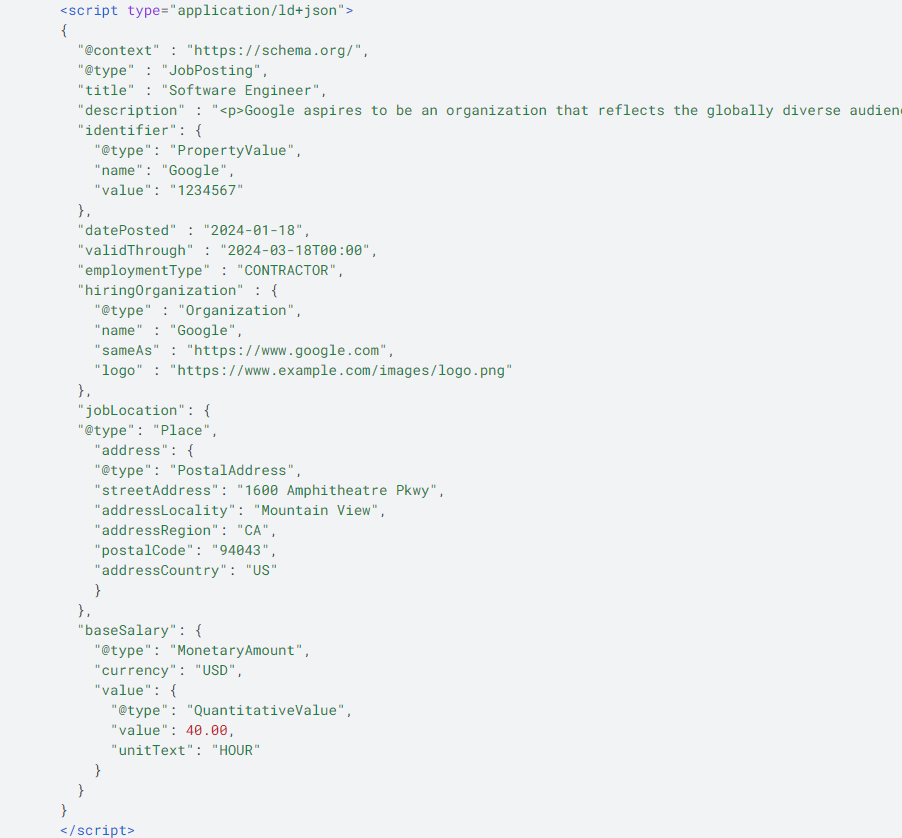Understanding Job Posting Schema for Job Boards
Job posting schema is a standardized format that helps search engines comprehend and display job listings accurately. Implementing this schema is crucial for job boards as it ensures their listings appear prominently in search results, improving visibility and attracting more organic traffic.

Types of Job Listings
Job boards typically handle various types of job listings:
- On-site jobs: Positions that require employees to work at a specific physical location.
- Remote jobs: Positions that can be performed from any location.
- Hybrid/Flexible jobs: Roles that combine remote work with on-site presence.
Key Schema Properties for Job Boards
When implementing job posting schema, job boards should focus on these essential properties:
- jobLocationType: Specifies if a job is remote (TELECOMMUTE) or on-site.
- applicantLocationRequirements: Defines geographic locations where employees can work for remote jobs.
- jobLocation: Indicates the physical location where the job can be performed, if applicable.
Common Implementation Issues for Job Boards
Job boards often encounter these challenges when implementing job posting schema:
- Missing applicantLocationRequirements: Failing to set this required element for remote jobs.
- Incorrect applicantLocationRequirements: Improperly structuring the field.
- Not marking remote jobs: Neglecting to add remote schema parameters.
- No schema implementation: Choosing not to include schema for certain job types.
Best Practices for Job Board Schema Implementation
To ensure proper schema implementation, job boards should:
- Provide accurate location information: Include detailed address data for on-site jobs.
- Correctly mark remote jobs: Use both jobLocationType and applicantLocationRequirements for remote positions.
- Handle hybrid jobs appropriately: Include all three location-related fields for hybrid roles.
- Validate implementations: Use the Rich Results Tool to verify schema correctness.
Key Points for Job Boards
To maximize the benefits of job posting schema:
- Specify at least one country for remote job eligibility.
- Ensure remote requirements have the correct type and value.
- Use TELECOMMUTE for fully remote positions.
- Validate all implementations thoroughly.
Based on the Google developer documentation for job posting structured data, here are some key points to consider when implementing jobPosting schema for job boards:
Essential Properties
When implementing jobPosting schema, job boards should include these required properties[1]:
- title
- description
- datePosted
- validThrough
- hiringOrganization
- jobLocation (for non-remote jobs)
For remote jobs, use:
- jobLocationType: "TELECOMMUTE"
- applicantLocationRequirements
Recommended Properties
To provide more comprehensive job information, job boards should also consider including these recommended properties[1]:
- baseSalary
- employmentType
- hiringOrganization.logo
- jobBenefits
- qualifications
- responsibilities
- skills
Citations: [1] https://www.alexanderchukovski.com/implementing-job-posting-schema-for-remote-jobs/
Best Practices for Job Boards
-
Use separate pages: Create individual pages for each job posting rather than listing multiple jobs on a single page[1].
-
Keep content consistent: Ensure the structured data matches the visible content on the page[1].
-
Remove expired listings: Use the validThrough property to indicate when a job posting expires, and remove expired listings promptly[1].
-
Provide accurate location data: For on-site jobs, include detailed address information. For remote jobs, use the appropriate remote job properties[1].
-
Use sitemaps: Submit a sitemap of your job posting URLs to help search engines discover and index your listings more efficiently[1].
Handling Different Job Types
Job boards should adapt their schema implementation based on the job type:
-
On-site jobs: Include detailed jobLocation information[1].
-
Remote jobs: Use jobLocationType: "TELECOMMUTE" and specify applicantLocationRequirements[1].
-
Hybrid jobs: Include both on-site location details and remote work information[1].
Salary Information
When including salary data, job boards should:
- Use the baseSalary property
- Specify the currency using ISO 4217 format
- Include the unitText (e.g., "HOUR", "MONTH", or "YEAR")
- Provide a value or a range (minValue and maxValue)[1]
Standard job posting example using JSON-LD code.

Validation and Testing
Job boards should regularly validate their schema implementation using:
- Google's Rich Results Test tool
- Schema Markup Validator
- Google Search Console for monitoring and addressing any structured data issues[1]

Validating jobPosting schema for a job page with the Google 's Rich Results Test tool
By following these guidelines, job boards can improve their visibility in search results, attract more qualified candidates, and provide a better experience for both employers and job seekers.
In the Google article "Job posting (JobPosting) structured data for Job Search" from their documentation you will find all you need to implement jobPosting schema in your job board
How to implement Google Indexing API?
Read the article: How to Integrate Google Indexing API for job posting URLs





